Former President Donald Trump’s “America First” trade agenda set out with a bold ambition: bring manufacturing jobs back to the United States. Central to that plan was encouraging domestic production across industries — including apparel. Yet despite political momentum and public support for “Made in America” labels, the fashion sector has struggled to bring large-scale garment manufacturing back home. Why?
The short answer: structural challenges outweigh patriotic intent.
The Allure of Local Production
In theory, domestic manufacturing offers clear advantages: shorter supply chains, faster turnaround times, improved quality control, and better transparency for sustainability-conscious consumers. It also aligns with the growing demand for ethically made products and gives brands more control over labor practices.
And there’s certainly interest from American consumers. In an era of rising scrutiny over fast fashion and overseas labor, shoppers are increasingly interested in locally made goods. A “Made in the USA” label can elevate a product’s perceived value, even justify a higher price.
The Reality: High Costs and Limited Capacity
Despite this interest, apparel production in the U.S. remains a niche operation. Here’s why:
1. Labor Costs Are Substantially Higher
In global garment hubs like Bangladesh, Vietnam, and China, the cost of labor is significantly lower. This cost advantage allows companies to keep retail prices competitive. By contrast, U.S. minimum wages — and expectations around labor rights — are much higher, making domestic apparel production more expensive, especially for labor-intensive tasks like cutting and sewing.
2. Infrastructure Is Insufficient
The U.S. no longer has the robust garment manufacturing infrastructure it once boasted. While some clusters still exist — Los Angeles for denim and casualwear, New York for high-end fashion — many factories have closed, and the skilled labor force has shrunk. Training new garment workers takes time, and without large-scale government or private investment, growth remains slow.
3. Economies of Scale Are Difficult to Achieve
Apparel brands typically require large runs of identical garments to meet demand and maintain profitability. Most American factories cater to small-batch or bespoke production — great for emerging designers or capsule collections, but impractical for brands selling at scale.
4. Global Supply Chains Are Still Dominant
Even if clothing is stitched together in the U.S., many fabrics and trims are still imported. The textile industry — once a backbone of American manufacturing — has largely shifted overseas. Without a reliable domestic source for materials, the “Made in America” tag often applies to assembly, not full-scale production.
The Exceptions: Niche Success Stories
Some brands have successfully built their identities around American production. Companies like American Giant, Buck Mason, and Todd Shelton pride themselves on sourcing and manufacturing in the U.S. They cater to consumers willing to pay a premium for quality and transparency. Similarly, luxury and heritage brands like Schott NYC or Raleigh Denim Workshop operate small-scale operations with tight quality control.
But these are exceptions — not the rule. For most mass-market retailers, American manufacturing remains cost-prohibitive.
Government Policy: More Rhetoric Than Results?
Under Trump, tariffs on imported goods — especially from China — were meant to level the playing field for U.S. manufacturers. But instead of re-shoring jobs, many brands simply shifted production to other low-cost countries like Vietnam, India, and Bangladesh. Tariffs increased costs for American companies without necessarily making U.S. production more competitive.
For real change, experts argue, the U.S. would need to invest in:
- Workforce development and training in garment skills.
- Tax incentives for domestic production.
- Modernized factories and machinery.
- A revitalized textile supply chain.
Looking Ahead
As sustainability and ethical production continue to shape consumer preferences, there may be renewed interest in regionalizing supply chains — not just in the U.S., but in Europe and Latin America, too. And innovations in automation could help reduce labor costs over time, making local manufacturing more viable.
Still, unless brands and policymakers commit to serious structural reform, the dream of a thriving American apparel industry will remain more aspirational than actual. For now, “Made in America” is a luxury — not a standard.






